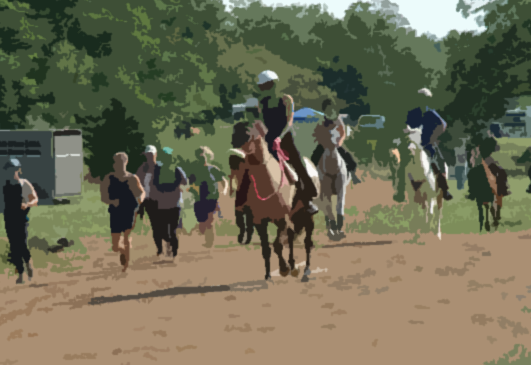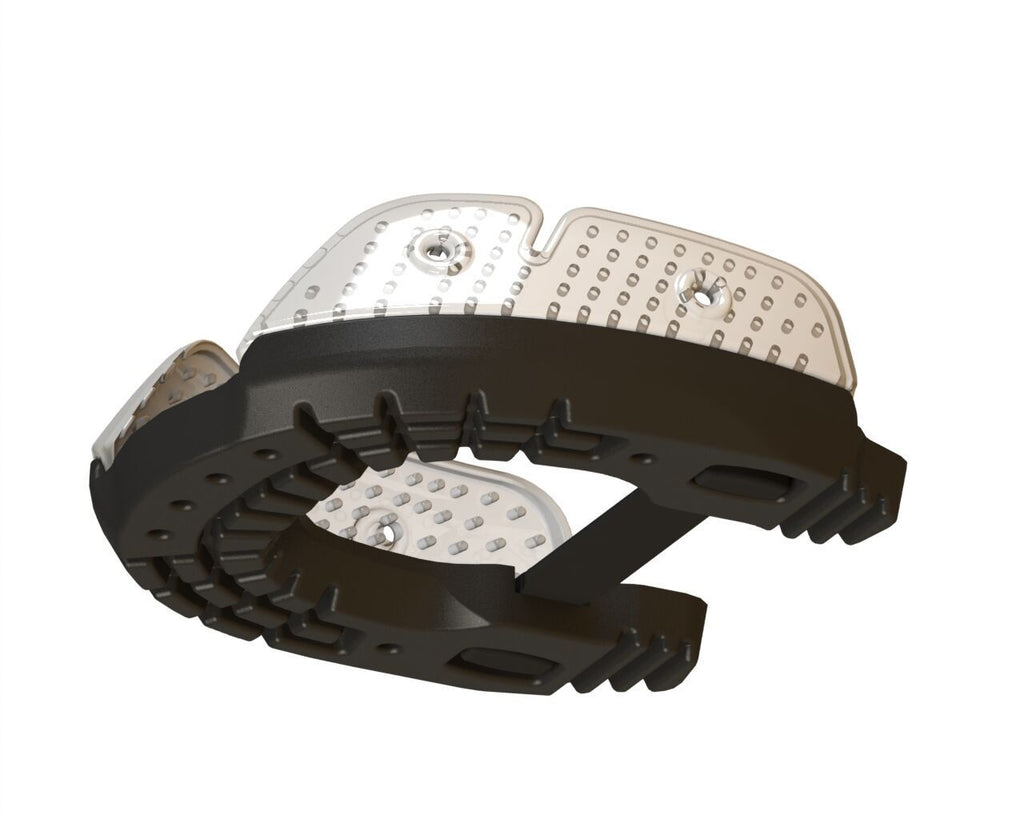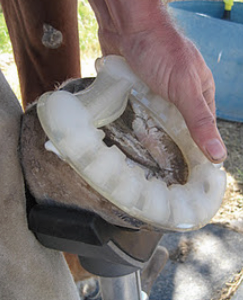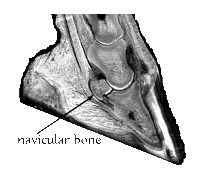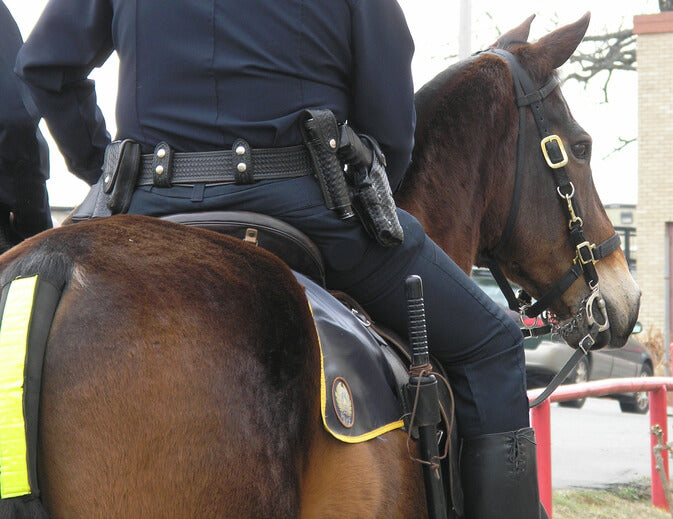HOOF-it Blog
Horseshoe Materials Throughout The Years
The horseshoe goes back thousands of years but not in the way we know it now. Though some of the first horseshoes used by ancient Asian and then Roman riders were made of leather, the technology has changed and developed over centuries to include metal and now even plastic/composite horseshoe materials. century, iron shoes were generally used. With the most changes being seen in the last century, we now have access to a variety of materials meant for a variety of functions.
By 1000 A.D., the use of cast bronze horseshoes was common in Europe and, by the 14th century, iron shoes were generally used. With the most changes being seen in the last century, we now have access to a variety of materials meant for a variety of functions.
Steel vs. aluminum 
Most horseshoes are made from steel or aluminum. The material is chosen depending on what function the shoe is going to perform as well as what job the horse will be performing. The material that is chosen will have a large impact on the horses’ performance, overall stability and hoof health. Steel is heavier and very sturdy, while aluminum shoes are lighter but tend to have to be replaced more often. Heavy horses that are driven or worked need a more hard-wearing shoe as do horses that do a lot of high impact work like jumping or trails and may benefit from a sturdier shoe. Horses that spend most of their time on soft footing won’t need to worry as much about having a sturdy shoe and may benefit from a softer aluminum shoe. There are manufacturers that make a rubber-coated steel shoe, which has the benefit of more grip and cushioning for the horse. The structure of the hoof will also play a big part in what kind of shoe the horse can wear. Thin-walled hooves can be softer and may require a different shoe than that of a thicker walled hoof that is naturally harder. Steel shoes will wear down less quickly and you will get longer use out of them where aluminum shoes are softer, wear down quicker and will need to be replaced sooner.
Plastic/composite horseshoes 
Plastic or composite horseshoes have been on the market for 20 years or more and are made from a number of composites that are designed to replicate the hardness of a healthy horses’ natural hoof. Some plastic shoes have a steel or aluminum core and some are composite materials only. They can reduce concussion and improve traction. composite horseshoes with no steel or aluminum core offer significantly more shock absorption for those horses on street surfaces such as the carriage or police horses. They are lightweight and flex with the horses’ foot, come in a variety of sizes to support the hoof structure and can be trimmed by your Farrier for a custom fit. They can be glued or nailed on so they are beneficial to horses with many different hoof structures and also different hoof problems. Composite shoes are durable, lighter weight and can aid in reducing discomfort from a variety of chronic conditions such as ringbone, laminitis and navicular disease. Thermal imaging studies also confirmed improved overall circulation.
There are a lot of options out there and knowing what is right for your horse, and their feet can make all the difference in their performance and overall hoof health.
Preparing for your Farriers
Navicular Syndrome
Performance Horse Shoeing Tips
No matter what kind of performance horse you might happen to have, cutting, reining, roping, or pleasure, one thing is a constant fact: your horse must be in balance with his body to perform at his optimal level. It is your farrier’s job to trim and shoe your horse to allow for optimal balance.
I have been lucky with my reining cow horse, Smoke ‘em. He has never needed any corrective shoeing. I simply have my farrier trim him flat and level based on the conformation of each of his legs. I have his feet trimmed short to ensure that he moves naturally. Horses with toes that are too long or heels that are too high do not stride naturally and do not look pretty to the judges. Eventually, excessively long feet cause problems that may require correction and even rehabilitation down the road. You can compare this problem to the human athlete. If a runner wore shoes one size too small, or too large, for even one training session he would feel a lot more stress and strain in the legs than with shoes which fit properly. The same is true for your horse. The most important factor in the shoeing of your performance horse is to have him land level on the ground, You can notice this by observing your horse move at a walk. View him from the front and from the side. Does the inside or the outside of the shoe hit the ground first? Or, does he put the entire hoof down level? If his walk is level, he will most likely lope and trot level also. And, most importantly for cow horses, he will stop level also. If he does not land perfectly level his timing (and yours) will be off. This problem will only get worse as you work him at a quicker pace. Remember, all foot and leg problems intensify as the horse moves faster. The best way to make decisions about your performance horse’s shoeing needs is to watch him move from the ground, and learn to listen to your seat. If you have any tips on shoeing the performance horse please post them here and share your experience.
Barefoot vs. Shoeing
Navicular Syndrome and HOOF-it Composite Horseshoes
 Dear HOOF-it Technologies:
My mare was diagnosed with “Navicular Syndrome”. One day I noticed that her stride had become short and stabby like. We took her to the vet for a full examination and x-rays and sure enough she was diagnosed with “Navicular Syndrome”. The vet prescribed meds (isoxsuprine) that were given to her religiously but she still seemed too uncomfortable to go back to her regular workouts. After looking on the internet I found your HOOF-it plastic horseshoes and was eager to try them. I bought a pair and gave them to my farrier to put on. My farrier is a bit of a traditionalist and gave me a cross eyed look but after some convincing he went ahead and put them on. Much to our amazement she walked out of the cross ties a different horse. We put her on a line and her movement was night and day. Her short and stabby stride became once again free and long. She has now been able to go back to regular work and has even been shown in the childrens hunters. I know she will never go back to the 3’6 ring but she is comfortable and happy. Who could ask for anything more? Thank you for making a horseshoe that just makes sense!
Sincerely,
Ann Alexander
Dear HOOF-it Technologies:
My mare was diagnosed with “Navicular Syndrome”. One day I noticed that her stride had become short and stabby like. We took her to the vet for a full examination and x-rays and sure enough she was diagnosed with “Navicular Syndrome”. The vet prescribed meds (isoxsuprine) that were given to her religiously but she still seemed too uncomfortable to go back to her regular workouts. After looking on the internet I found your HOOF-it plastic horseshoes and was eager to try them. I bought a pair and gave them to my farrier to put on. My farrier is a bit of a traditionalist and gave me a cross eyed look but after some convincing he went ahead and put them on. Much to our amazement she walked out of the cross ties a different horse. We put her on a line and her movement was night and day. Her short and stabby stride became once again free and long. She has now been able to go back to regular work and has even been shown in the childrens hunters. I know she will never go back to the 3’6 ring but she is comfortable and happy. Who could ask for anything more? Thank you for making a horseshoe that just makes sense!
Sincerely,
Ann Alexander
Plastic Horseshoes
Customer Questions on HOOF-it Composite Horseshoes
 Answer:
Dear Potential Customer:
Thank you for your interest in HOOF-it composite horseshoes. Horses wearing our composite shoes benefit in many ways...
Here are just a few: -Light in weight - Shock absorption -Increase of blood flow (see graphic) -Less stress on tendons and joins
Our composite shoes are quite durable. The average horse will get at least one reset. I have actually had customers call and tell me that they have reset our shoes 5 times. Although I would never recommend re-setting a shoe that many times... I do hear about it quite often. On the other hand if you are doing highly competitive endurance riding or have working driving horses that are on asphalt all day 5 days a week you will probably only get one shoeing comfortably out of our shoes.
As for nails... yes (most) any regular horseshoe nails will work.
Regards,
Team HOOF-it
Answer:
Dear Potential Customer:
Thank you for your interest in HOOF-it composite horseshoes. Horses wearing our composite shoes benefit in many ways...
Here are just a few: -Light in weight - Shock absorption -Increase of blood flow (see graphic) -Less stress on tendons and joins
Our composite shoes are quite durable. The average horse will get at least one reset. I have actually had customers call and tell me that they have reset our shoes 5 times. Although I would never recommend re-setting a shoe that many times... I do hear about it quite often. On the other hand if you are doing highly competitive endurance riding or have working driving horses that are on asphalt all day 5 days a week you will probably only get one shoeing comfortably out of our shoes.
As for nails... yes (most) any regular horseshoe nails will work.
Regards,
Team HOOF-it
Horseshoe for Mounted Patrol Horses
Minneapolis Police Mounted Patrol
Thank you for your help in addressing the concerns of the Minneapolis Police Mounted Patrol Unit regarding shoes for our horses.
When I first contacted you, we were preparing for protests related to the International Scientists of Animal Genetics conference that was being held in our City. We were looking for a shoe for our horses that would provide proper grip on the wide variety of surfaces our horse's encounter, as well as flexibility and durability.
We received our order in less than a week and our Farrier had no problem putting the shoes on. The test would be how they held up during the protests. During the protests, we had other Mounted Patrol Units from other agencies providing mutual aid. One of the things we noticed immediately was the fact that our horses had much less slipping than the horses from the other agencies that were using steel shoes, barium shoes, or a combination (steel with barium tips).
Our horses definitely had much better footing, which was a great advantage! The shoes have been extremely durable while remaining flexible, which is healthier for the hoof.
We are very pleased with the performance of your HOOF-it shoes and plan to continue to use them in the future. Thanks again! I look forward to meeting you soon.
Sincerely,
Officer Angela M. Dodge Minneapolis Police Department Mounted Patrol Unit Coordinator

